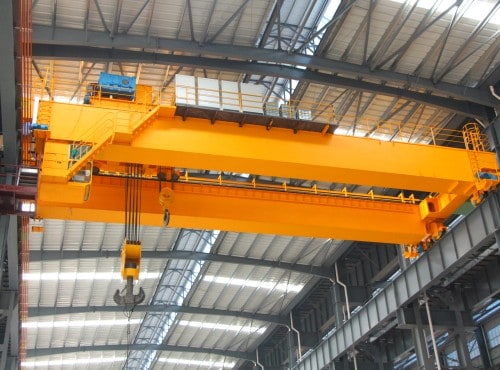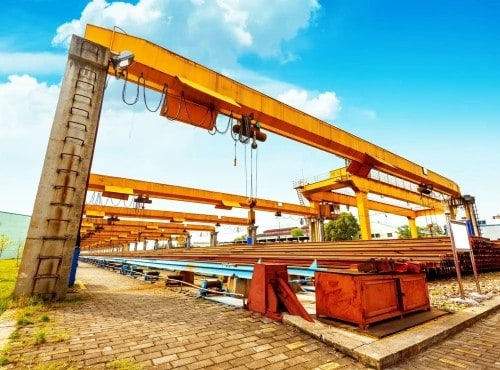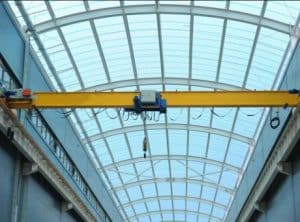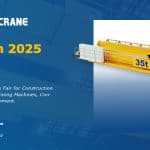Según la estructura del marco de la puerta, se divide en grúa pórtico y grúa pórtico voladiza.
Grúa pórtico
1. Grúa pórtico completa: la viga principal no tiene voladizo y el carro se transporta dentro del tramo principal.
2. Grúa semipórtico: Los estabilizadores tienen una diferencia de altura, que se puede determinar de acuerdo con los requisitos de ingeniería civil del sitio.
Grúa pórtico en voladizo
1. Grúa pórtico de doble voladizo: la forma estructural más común, la fuerza de la estructura y el uso efectivo del área del sitio son razonables.
2. Grúa pórtico con voladizo simple: esta forma estructural a menudo se selecciona debido a las limitaciones del sitio.
Según la forma de la viga principal
1. Grúa pórtico de una sola viga
La grúa pórtico de una sola viga principal tiene una estructura simple, es fácil de fabricar e instalar y su propio peso es pequeño. La mayor parte de la viga principal es una estructura de marco de caja de riel parcial. En comparación con la grúa pórtico de doble viga, la rigidez general es más débil. Por lo tanto, esta forma se puede utilizar cuando la capacidad de elevación Q ≤ 50t y el tramo S ≤ 35m. Hay dos tipos de patas de pórtico en forma de L y en forma de C para grúas pórtico de una sola viga. El tipo L es fácil de fabricar e instalar, tiene una buena condición de tensión y su propia masa es pequeña, pero el espacio para izar mercancías a través de los estabilizadores es relativamente pequeño. La pata en forma de C está hecha en una forma inclinada o curva, y el propósito es tener un espacio lateral más grande para que las mercancías puedan pasar a través de la pata sin problemas.
2. Grúa pórtico de doble viga
La grúa pórtico de doble viga principal tiene una gran capacidad de carga, una gran envergadura, una buena estabilidad general y muchas variedades, pero su propia calidad es mayor que la de la grúa pórtico de una sola viga principal con la misma capacidad de elevación, y el costo también es mayor. Según la estructura de la viga principal, se puede dividir en dos formas: viga cajón y cercha. En la actualidad, generalmente se utilizan estructuras en forma de caja.
Según la estructura de la viga principal
1. Viga de armadura
La forma estructural soldada mediante ángulo de acero o viga en I tiene las ventajas de bajo costo, peso ligero y buena resistencia al viento. Sin embargo, debido a los muchos puntos de soldadura y los defectos de la propia armadura, la viga de la armadura también tiene las desventajas de una gran deflexión, baja rigidez, confiabilidad relativamente baja e inspección frecuente de los puntos de soldadura. Es adecuado para sitios con menores requisitos de seguridad y menor capacidad de elevación.
2. Viga cajón
La placa de acero está soldada en una estructura de caja, que tiene las características de alta seguridad y alta rigidez. Generalmente se utiliza para grúas pórtico de gran y gran tonelaje. Como se muestra en la imagen de la derecha, la MGhz1200 es la grúa pórtico más grande de China con una capacidad de elevación de 1200 toneladas. La viga principal adopta una estructura de viga cajón. La viga cajón también tiene las desventajas de su alto costo, gran peso y poca resistencia al viento.
3. Viga alveolar
Generalmente se refiere a "viga en forma de panal triangular isósceles", la cara final de la viga principal es triangular, hay orificios en forma de panal en el vientre oblicuo en ambos lados y hay cuerdas en las partes superior e inferior. La viga de panal absorbe las características de la viga de armadura y la viga de cajón, y tiene mayor rigidez, menor deflexión y mayor confiabilidad que la viga de armadura. Sin embargo, debido a la soldadura de placas de acero, el peso propio y el costo son ligeramente más altos que los de las vigas de celosía. Es adecuado para sitios o patios de vigas que se utilizan con frecuencia o tienen una gran capacidad de elevación. Dado que este tipo de viga es un producto patentado, hay menos fabricantes.
por propósito
1. Grúa pórtico ordinaria
Este tipo de grúa adopta principalmente la estructura tipo caja y tipo armadura, que es la más utilizada. Puede transportar varias piezas y materiales a granel, con una capacidad de elevación de menos de 100 toneladas y una distancia de 4 a 39 metros. Las grúas pórtico ordinarias con cuchara tienen un nivel de trabajo más alto. Las grúas pórtico ordinarias se refieren principalmente a grúas pórtico de gancho, de cuchara, electromagnéticas, de polipasto y también incluyen grúas semipórtico.
2. Grúas pórtico para centrales hidroeléctricas
Se utiliza principalmente para levantar y abrir y cerrar puertas, y también se puede utilizar para operaciones de instalación. La capacidad de elevación es de 80 a 500 toneladas, el alcance es pequeño, de 8 a 16 metros; la velocidad de elevación es baja, de 1 a 5 metros por minuto. Aunque este tipo de grúa no se levanta con frecuencia, una vez que se utiliza, el trabajo es muy pesado, por lo que el nivel de trabajo debe elevarse adecuadamente.
3. Grúas pórtico para construcción naval
Se utiliza para montar el casco en el muelle, y siempre hay dos carros elevadores: uno tiene dos ganchos principales, que corren sobre la pista de la brida superior del puente; el otro tiene un gancho principal y un gancho auxiliar, que está en la brida inferior del puente que corre sobre rieles para voltear y izar grandes secciones del casco. La capacidad de elevación es generalmente de 100-1500 toneladas; la envergadura es de hasta 185 metros; la velocidad de elevación es de 2-15 metros por minuto, y también hay una velocidad de fretting de 0,1-0,5 metros por minuto.
4. Grúa pórtico para contenedores
Para terminales de contenedores. Después de que los remolques transportan los contenedores descargados del barco por el puente portacontenedores del muro del muelle hasta el patio o la parte trasera, se apilan mediante la grúa pórtico para contenedores o se cargan y transportan directamente, lo que puede acelerar la rotación del puente portacontenedores u otras grúas. El patio que puede apilar contenedores con una altura de 3 a 4 capas y un ancho de 6 filas es generalmente del tipo de neumático, pero también del tipo de riel. En comparación con el camión portacontenedores, la grúa pórtico para contenedores tiene un alcance y una altura mayores en ambos lados del marco del portal. Para satisfacer las necesidades de transporte de la terminal portuaria, este tipo de grúa tiene un nivel de trabajo más alto. La velocidad de elevación es de 8 a 10 metros por minuto; el alcance está determinado por el número de filas de contenedores que deben cruzarse, y el máximo es de aproximadamente 60 metros, lo que corresponde a la capacidad de elevación de contenedores de 20 pies, 30 pies y 40 pies de largo, que son aproximadamente 20 toneladas y 25 toneladas respectivamente. y 30 toneladas.



















